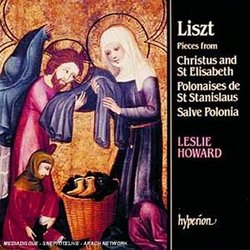| All Artists: Franz Liszt, Leslie Howard Title: Liszt: Pieces from Christus and St. Elisabeth; Polonaises de St. Stanislaus; Salve Polonia Members Wishing: 1 Total Copies: 0 Label: Hyperion UK Release Date: 9/10/1992 Album Type: Import Genre: Classical Styles: Opera & Classical Vocal, Chamber Music, Forms & Genres, Short Forms, Suites, Historical Periods, Classical (c.1770-1830) Number of Discs: 1 SwapaCD Credits: 1 UPC: 034571164663 |
Search - Franz Liszt, Leslie Howard :: Liszt: Pieces from Christus and St. Elisabeth; Polonaises de St. Stanislaus; Salve Polonia
 | Franz Liszt, Leslie Howard Liszt: Pieces from Christus and St. Elisabeth; Polonaises de St. Stanislaus; Salve Polonia Genre: Classical |
Larger Image |
CD Details |
CD ReviewsLiszt the Votary Hexameron | 10/12/2006 (5 out of 5 stars) "The oratorio genre has barely survived with today's audiences and their expectations. Surely the masterpieces from Handel, Haydn and Mendelssohn will always have a devout following, but many other composers' oratorios have been forgotten. Although the recording market has done wonders to resuscitate this neglected genre, few recognize Liszt's grand achievements demonstrated in his two oratorios, "Christus" and "St. Elizabeth." Leslie Howard and Hyperion have done nothing but good for the Liszt and indeed classical music discography. In this fourteenth volume of Hyperion's Liszt series, Howard presents piano transcriptions of selected movements from "Christus," "St. Elizabeth," and Liszt's unfinished "St. Stanislaus."
Written in 1864, Liszt's first oratorio, "St. Elizabeth," is a composition of excellent craft and genuine inspiration. Liszt creates convincing musical narrative and drama relating to the story of the Hungarian Saint Elizabeth. Those familiar with the oratorio can expect Liszt's transcriptions to exhibit his customary artistry and skill; he deftly transfers the orchestral and vocal parts to the solo piano medium. The contrasts of dynamics and textures of the sublime "Orchestral Introduction" are exquisitely underscored by the piano. The subsequent movement, "Crusaders' March," is ecstatic and grandiose, which Howard handles with booming splendor and even a flare of light-heartedness. Musically, this march is original and contains material as gorgeous as any march by Wagner. In the "Interludium," Liszt evinces memorable melodic climaxes and a mood of exultant triumph. It is amazing how effective the original music content, replete with orchestral nuances and soaring vocal lines, can resound on the piano. Indeed, Howard confirms in the liner-notes that "the piano writing is beautifully organised, and the textures never sound like a crude representation of an orchestral score." Liszt's second oratorio, "Christus," was completed a few years after "St. Elizabeth," and is based on the story of Christ's life. There are many Liszt scholars who consider "Christus" among Liszt's greatest compositions. I am indeed awed by this work and even more by Howard's renditions of the music for piano. The "Shepherds' Song at the Manger" is serene and overtly lyrical with a blissful theme that undergoes subtle development. On the piano, this "Song" has richness comparable to Brahms and is sincerely spiritual music. But the march of "The Three Holy Kings" is a masterpiece and successful evocation of program music. Liszt conveys the jubilance of the three kings on their journey to Christ, their zealous ebullience upon seeing the star, and their reverence while offering their gifts. Frankly, this is powerful piano music which communicates as much color and subtle gradations of mood as the orchestral version. "St. Stanislaus" is Liszt's unfinished oratorio, which he worked on for over ten years until his death. Howard records two Polonaises whose original versions have been lost. Calling them transcriptions is therefore difficult, but these pieces flaunt exceptional music substance. The first polonaise is morbid and depressive; a true mark of his late period. The material is reminiscent of "Funerailles," and has phrases and cadences with a vocal or "wailing" quality. The temperament of the second polonaise is the opposite: it is an elegant dance with occasional heroic fanfares like Liszt's own Polonaise in E major. "Salve Polonia" is the largest (16-minute) transcription and is perhaps the least accessible. While the main theme is solemn and memorable, Liszt's trail of development is not exactly straightforward. Liszt employs radical harmonization, emits a densely contemplative atmosphere, but there is deeply sublime music here with passionate crashes which work nicely on the piano. Bottom line: All of these transcriptions are being recorded for the first time, and Howard's singular musicianship and superb pianism are never questionable. These movements from Liszt's oratorios run the gamut of emotion and style of piano-writing, but they are anti-bombast and supremely spiritual." |
